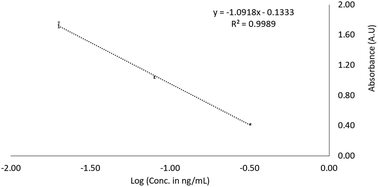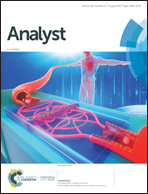Multiplexed ELISA screening assay for nine paralytic shellfish toxins in human plasma
Abstract
Paralytic shellfish poisoning is a lethal syndrome that can develop in humans who consume shellfish contaminated with paralytic shellfish toxins. These toxins have a short half-life in the human body, so a rapid diagnostic assessment of the poisoning is necessary. In this paper, we have developed and validated a rapid ELISA screening assay using anti-saxitoxin antibodies to screen nine toxins: saxitoxin; decarbamoyl saxitoxin; gonyautoxin 2,3; decarbamoyl GTX 2,3; neosaxitoxin; and gonyautoxin 1,4, in human plasma with lower limits of detection of 0.02, 0.08, 0.12, 1.2, 5.0, and 25 ng mL−1, respectively. Intra-day and inter-day precision experiments showed good reproducibility with a percent coefficient of variation less than 15%. The assay was 100% accurate in determining the presence or absence of these toxins in human plasma specimens. Blank specimens were assessed as negative for toxin content indicating that the method has excellent analyte specificity. This rapid screening assay can be used to quickly diagnose exposure to paralytic shellfish toxins, though an additional confirmatory method will be necessary to identify and quantitate the specific toxin in an exposure.



 Please wait while we load your content...
Please wait while we load your content...